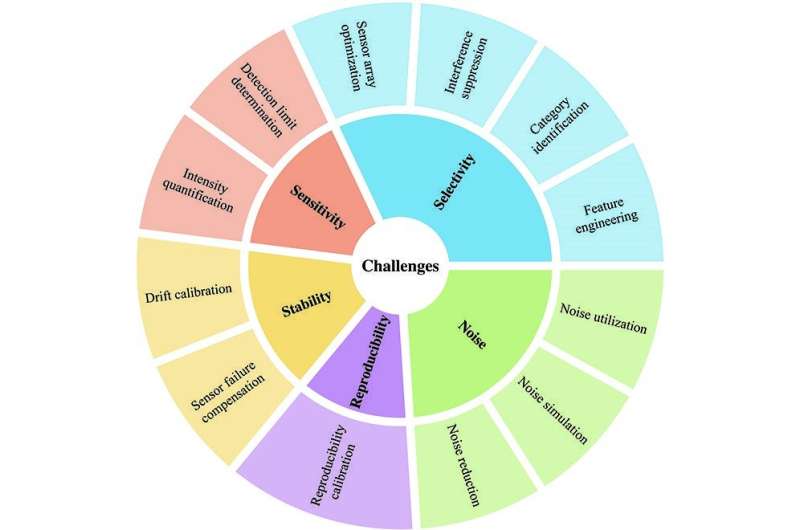This article has been reviewed according to Science X's editorial process and policies. Editors have highlighted the following attributes while ensuring the content's credibility:
fact-checked
proofread
How to make electronic noses smell better

Imagine if you could ask a machine to "smell" something for you with just a click of a button. That's what electronic noses, or e-noses, are for. They are systems that combine chemical gas sensors, signal processing and machine learning algorithms to mimic the sense of smell. E-noses can be used for many purposes, such as checking food quality, monitoring air pollution, diagnosing diseases and detecting explosives.
How do they work? What are the challenges and opportunities in this field? A team led by Jingdong Chen of Northwestern Polytechnical University in Xi'an, China and Weiwei Wu of Xidian University in Xi'an, China have recently explored these questions in a comprehensive review of the methods and algorithms developed for e-noses. The review discusses the limitations of current gas sensors and provides an outlook on algorithm design.
The review was published in Intelligent Computing.
E-noses artificially mimic the biological sense of smell. The gas sensors of the e-noses correspond to biological olfactory receptor neurons. When you sniff something, tiny molecules float through the air and enter your nose. Similarly, a gas sensor can capture airborne molecules through an air intake system. The sensor reacts to these molecules and changes in a way that can be measured by electronic signals. These signals are then converted from an analog format to a digital format so that computers can use algorithms to analyze and interpret the data.
The review summarizes existing methods and algorithms in the field of e-noses, grouping them according to a classification framework that highlights the challenges presented by the following limitations of gas sensors:
- Limitations on selectivity. When exposed to an odorant mixture, gas sensors respond to all stimuli in the mixture, making it difficult to distinguish different odors. They may also be affected by nontarget odors, and different sensors may respond differently to the same chemical stimulus.
- Limitations on sensitivity. Every gas sensor operates within a range defined by the minimum and maximum quantity it is able to detect. Some are more sensitive than others, but the range of a particular sensor is not always known. Sensors also vary in their ability to accurately detect odor concentration.
- Limitations on stability. Gas sensors often do not produce a stable and reproducible response to the same chemical stimuli due to material aging, environmental changes or sensor failure.
- Limitations on reproducibility. Two gas sensors of the same type may have different responses to the same gas under the same conditions.
- Limitations on noise. Gas sensors are affected by external and internal noise. Sources of external noise include background odor variation, turbulence of airflow and changes in temperature, humidity and pressure in the surrounding environment. Internal noise consists of noise generated by the measurement circuits and the sensors themselves.
Despite the significant progress made in the last few decades, the large-scale deployment of e-noses in practical applications still has a long way to go.
The authors of the review believe that ensuring the robustness of e-nose systems should be a top priority for future research and development. While odor identification and intensity quantification have been widely investigated, there are several crucial tasks that demand greater attention.
These include interference suppression and recognition, optimization of sensor arrays, detection of sensor drift and failure, noise reduction and utilization, and determining the limit of detection, among others. In addition, they say it is important to delve into the fundamental mathematical model of the sensing mechanisms, which is the foundation for solving many issues related to e-noses.
More information: Taoping Liu et al, Review on Algorithm Design in Electronic Noses: Challenges, Status, and Trends, Intelligent Computing (2023). DOI: 10.34133/icomputing.0012



















